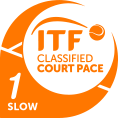Where to install
The Redbrick Tennis surface, in addition to being the ideal solution for the construction of new courts, can be applied to all major existing tennis subbases and surfaces, avoiding costly and demanding demolition work.
Since 2016 we have introduced a new solution: Redbrick Reverso, the system that allows you to transform your synthetic grass court, even if heavily worn, into the original red clay surface on a synthetic base, certified ITF 1 slow.

Construction of a brand-new tennis court
The most cost-effective and environmentally friendly subbase compared to any other synthetic surface. Redbrick does not require any type of compact subbase (concrete slab or asphalt), but only a well-leveled and compacted draining base in crushed stone, finished with sand.

Transformation of a synthetic grass court on a draining subbase
In the case of synthetic grass courts laid on a draining subbase, it is recommended as a first step to remove the old carpet, in order to fully benefit from the absorption capabilities of the Redbrick system.
Subsequently, once the absence of irregularities has been verified (and corrected if necessary), the new surface can be installed without any further work.

Transformation of a Mateco court
Redbrick is perfectly suited for the conversion of an old porous concrete (Mateco) court. In the presence of cracks or irregularities, it will be sufficient to carry out filling or smoothing, and then directly lay the new surface on top. The old Mateco base, combined with the excellent absorption capacity of the new system, will ensure rapid drainage even after heavy rainfall.

Transformation of an acrylic resin court
Redbrick does not require costly renovation of an old “fast” court in acrylic resins. Any “hard” surface, as long as it is flat, is an excellent base for conversion with the Redbrick system, except for minor irregularities which, if present, can be corrected at a very low cost.

Transformation of a clay court
In the case of outdoor courts, before installing the Redbrick system, it is essential to stabilize the existing clay surface by laying a draining geotextile membrane followed by the creation of a well-leveled and compacted draining crushed stone layer (minimum thickness 4/5 cm), finished with sand. For courts with permanent covers (geodesic structures or wooden sports covers), instead, it is sufficient to level the existing clay court, with possible surface profile refinement through the application of inert material with selected grain size.
